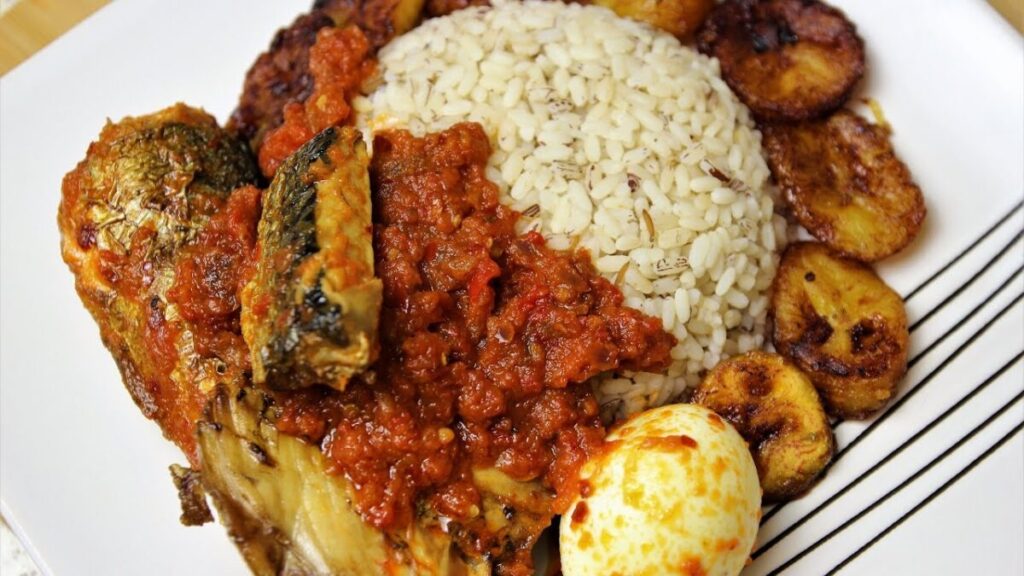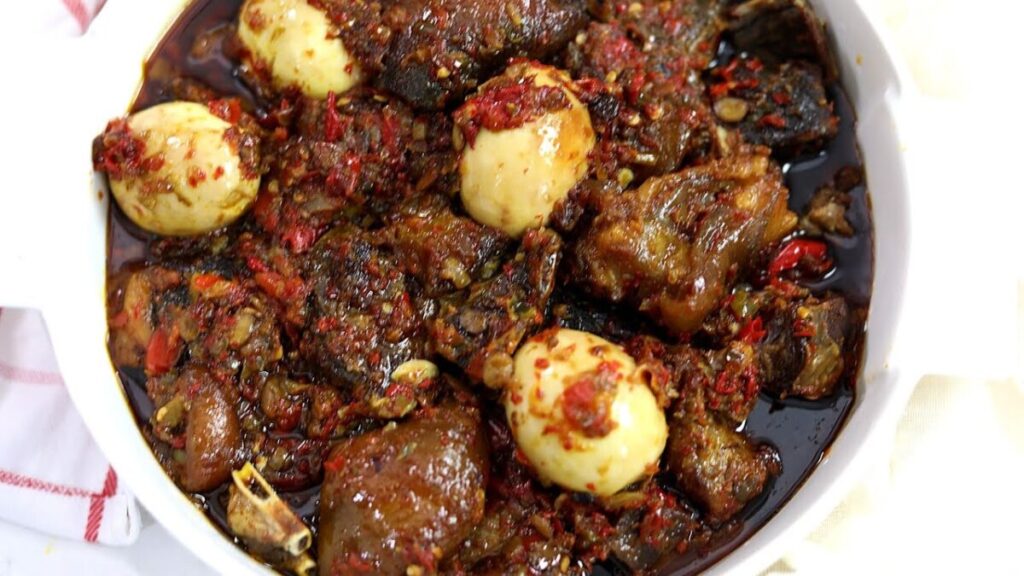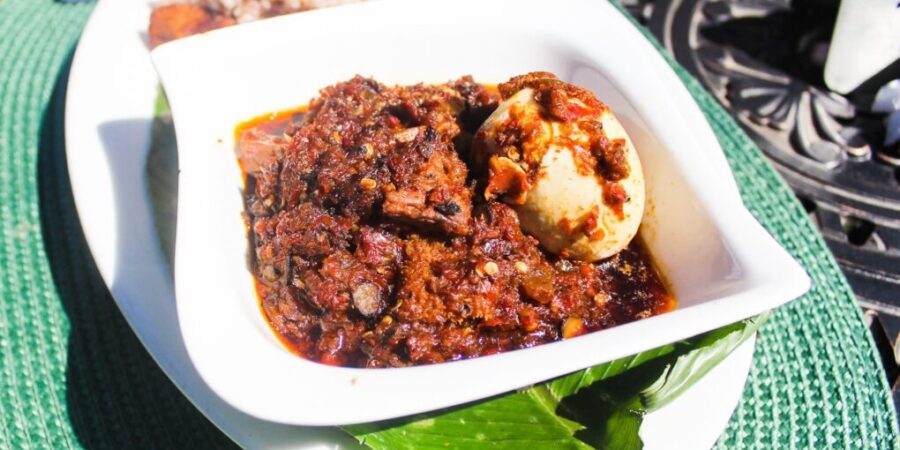How to make Ofada rice, the famous Nigerian rice variety, is a question that many food enthusiasts and lovers of Nigerian cuisine ask.
Ofada rice is known for its unique taste, texture, and aroma, and it has become a staple in many Nigerian homes and restaurants.
This article will provide you with step-by-step instructions on how to cook Ofada rice, along with tips and tricks to achieve perfectly cooked rice every time.
This guide will help you master the art of cooking Ofada rice and impress your family and friends with your culinary skills.

READ ALSO:
What is Ofada Rice?
Ofada rice is a unique variety of rice that is popular in Nigeria, particularly in the southwestern region of the country. It is short-grained, brown rice that is grown and cultivated locally.
Unlike other types of rice that are polished to remove the outer layer, Ofada rice is only partially milled, which leaves the outer layers intact. This gives the rice a distinct nutty flavour and a slightly chewy texture.
Ofada rice is traditionally served with a spicy stew made from assorted meats, vegetables, and a blend of spices. This stew is known as “Ofada stew” or “Ayamase”, and it is usually prepared with green bell peppers, locust beans, and palm oil.
The combination of flavorful rice and spicy stew is a popular delicacy in Nigeria, particularly among the Yoruba people.
SEE:
Cultural Significance of Ofada Rice
The cultural significance of Ofada rice in Nigeria is rooted in its history and origin. Ofada rice is believed to have been named after a town in Ogun State called “Ofada”.
The rice was originally cultivated by local farmers in the town and was mainly consumed by the residents. However, over time, the popularity of Ofada rice grew, and it became a staple food in many parts of the country.
Ofada rice is also significant because it is a locally produced food that supports the Nigerian economy. It is grown by small-scale farmers who rely on the sale of rice for their livelihoods. By consuming Ofada rice, Nigerians support local farmers and contribute to the growth of the agricultural sector in the country.
In addition to its cultural significance, Ofada rice is also considered a healthier alternative to other types of rice. Because it is only partially milled, Ofada rice retains more of its natural nutrients, including fibre, vitamins, and minerals. It is also lower in calories and has a lower glycemic index compared to other types of rice.
Overall, Ofada rice is a unique and culturally significant food in Nigeria that has gained popularity both locally and internationally. Its distinct flavour and nutritional benefits make it a healthy and delicious choice for anyone looking to try something new.
READ ALSO:
Tips on how to choose the best Ofada rice
Choosing the best Ofada rice can be a bit tricky, especially if you are not familiar with the rice variety. Here are some tips to help you choose the best Ofada rice:
Look for Authenticity
When purchasing Ofada rice, it is important to look for the authenticity of the product. Ofada rice is a local Nigerian rice, so it is best to buy from a trusted supplier who sources the rice from Nigeria.
Check the Packaging
Check the packaging of the rice for any signs of damage, such as tears or holes. Also, check the expiration date to ensure that the rice is fresh.
Check the Color
Ofada rice has a unique colour that sets it apart from other rice varieties. The rice should have a mix of brown and beige. This is due to the presence of rice husks that are not removed during processing.
Check the Texture
Ofada rice has a slightly rough texture compared to other rice varieties. You can run your fingers through the rice to feel the texture.
Smell the Rice
Ofada rice has a distinct aroma that is slightly nutty and earthy. If the rice has a sour or mouldy smell, it is not fresh and should not be used.
By following these tips, you can choose the best Ofada rice for your recipe and ensure that you get the most flavour and nutritional benefits from the rice.

Ingredients for Ofada Rice
The following are the ingredients needed for making Ofada rice:
Ofada Rice – 2 cups
Water – 4 cups
Salt – 1 teaspoon
Onion – 1 medium-sized bulb
READ: Ofada Rice: The Black Sheep of the Owambe Family
Cleaning and Soaking Ofada Rice
Cleaning and soaking Ofada rice is a critical step in preparing it for cooking.
Here are the steps to take in cleaning the rice:
Measure the desired amount of rice and place it in a large bowl.
Rinse the rice under running water to remove dirt, debris, and excess starch. You can use a colander to make this process easier.
Use your hands to agitate the rice in the water, rubbing the grains together gently. This helps to remove any dirt or debris that may be clinging to the rice.
Drain the rice and repeat the process of rinsing and agitating until the water runs clear. This may take two to three washes.
After washing the rice, fill the bowl with water and let it soak for at least 30 minutes. Soaking the rice helps to soften the grains and shorten the cooking time.
After soaking, drain the water and rinse the rice once more before cooking.
Note: Some people prefer to wash and soak Ofada rice overnight, which can help to enhance the flavour and texture of the rice. However, be sure to change the water a few times if soaking overnight to avoid fermentation.
Importance of soaking Ofada Rice
Soaking Ofada rice before cooking is an important step that helps to:
Soften the rice
It helps to soften the grains, making them easier to cook and digest. This is especially important for older or tougher grains of rice, which may take longer to cook and be less enjoyable to eat.
Reduce cooking time
Soaking Ofada rice before cooking helps to reduce the cooking time, especially for large batches.
Improve texture and taste
It helps to improve its texture and taste by allowing it to absorb water and swell up. This makes the rice more tender and flavorful, with a softer and fluffier texture.
SEE: How to make peanut: A step by step guide
Remove impurities
Soaking Ofada rice helps to remove any impurities or dirt that may be present on the rice grains.
Overall, soaking Ofada rice before cooking is a simple step that can greatly improve the quality and taste of the rice, making it more enjoyable to eat.
How to cook Ofada rice

Ofada rice is known for its unique taste, texture, and aroma, and it has become a staple in many Nigerian homes and restaurants.
Step 1
Place the rice in a medium-sized pot and add 4 cups of water.
Step 2
Add salt to taste, and stir the rice and water to combine.
Step 3
Place the pot on a stove over medium-high heat and bring the
water to a boil.
Step 4
Once the water starts boiling, reduce the heat to low, and cover the pot with a tight-fitting lid.
Step 5
Let the rice simmer on low heat for 30-40 minutes, or until all the water has been absorbed and the rice is tender.
Step 6
Turn off the heat and let the rice sit covered for 5-10 minutes to allow it to fully absorb the moisture and become fluffier.
Step 7
After 5-10 minutes, remove the lid and fluff the rice gently with a fork.
SEE: Tastiest Nigerian Street Foods
How to make Ofada Rice Stew
Ingredients for making Ofada Stew
Here are the ingredients needed for making Ofada stew:
- Ofada peppers (Ata-Rodo) (as much as you like)
- Red bell pepper (as much as you like)
- Onion (1 large onion or 2 small onions)
- Tomatoes (3-4 medium-sized tomatoes)
- Palm oil (1/2 cup)
- Assorted meat (cow skin, Shaki, beef) (1/2 kg)
- Stockfish (1 medium-sized)
- Dry fish (2 medium-sized)
- Crayfish (2 tablespoons)
- Salt and seasoning cubes
- Locust beans (Iru) (optional)
- Smoked prawns
Note: It’s important to use Ofada pepper for this stew as it gives the dish its distinct taste and aroma. If you cannot find peppers, you can use habanero peppers instead, but the taste will be slightly different. Make sure to wash and clean the meat, stockfish, and dry fish before use.

Making the Ofada Stew
Wash and clean the assorted meat, then boil with one seasoning cube until the meat is cooked and tender. Set aside.
In a separate pot, heat up the palm oil on medium heat. Allow to heat up for about 5 minutes.
Add some locust beans (Iru) to the pot. The quantity of locust beans to add depends on personal preference.
Add the chopped onions and fry until it becomes translucent.
Add the blended peppers to the pot and fry for about 20-30 minutes or until the pepper sauce reduces and the oil separates from the pepper mixture.
Add the boiled assorted meat to the pot of pepper sauce.
Add the second seasoning cube and salt to taste.
Allow the stew to simmer for another 10-15 minutes.
If you are using smoked fish, you can add it to the stew towards the end and let it simmer for about 5 more minutes.
Your Ofada stew is now ready to serve with your cooked Ofada rice.
Note: Ofada stew can be served with other types of rice, but it is traditionally served with Ofada rice.
READ: Jollof rice vs Fried rice: Battle for Owambe supremacy
Ofada Rice Nutritional Benefits
Ofada rice is known for its unique flavour and texture, and it also offers a variety of nutritional benefits.
These are some of the nutritional benefits of Ofada rice:
Rich in Fiber
Ofada rice is a good source of dietary fibre, which is important for digestive health. Fibre helps to prevent constipation and promotes regular bowel movements.
High in Protein
The local rice is also a good source of protein, which is essential for building and repairing tissues in the body. Protein is also important for maintaining healthy skin, hair, and nails.
Contains Essential Minerals
It contains essential minerals such as magnesium, phosphorus, and potassium, which are important for maintaining healthy bones and teeth, regulating blood pressure, and supporting heart health.
SEE: Jollof rice vs Fried rice: Battle for Owambe supremacy
Low Glycemic Index
The rice has a low glycemic index (GI), which means it does not cause a rapid spike in blood sugar levels. This makes it a good choice for people who are trying to manage their blood sugar levels or who have diabetes.
Gluten-Free
Ofada rice is naturally gluten-free, making it a good option for people who have gluten intolerance or celiac disease.
Antioxidant Properties
The rice is also believed to have antioxidant properties, which help to protect the body against damage caused by free radicals. Antioxidants are important for maintaining healthy cells and reducing the risk of chronic diseases such as cancer and heart disease.
Overall, Ofada rice is a nutritious and healthy option that offers a range of health benefits. By incorporating it into your diet, you can enjoy its unique flavour while reaping the many benefits it has to offer.
READ: How to cook fried rice one step at a time
Conclusion
In conclusion, Ofada rice is a delicious and nutritious option that has become increasingly popular in Nigeria and around the world. Whether you are just trying it for the first time or just getting the hang of it, following the right steps and tips can help you achieve perfectly cooked rice every time.
In addition to its unique flavour and texture, Ofada rice also offers a range of health benefits, including fibre, protein, essential minerals, and antioxidant properties.
By incorporating Ofada rice into your diet, you can enjoy a tasty and healthy meal that is sure to satisfy your taste buds and provide you with the nutrients your body needs. So why not give it a try today and discover the many benefits of this delicious and nutritious rice variety?
Related Articles:
- 20 Healthy Smoothie Recipes for a Delicious and Energizing Breakfast”
- 20+ Amazing Cookout Menu Ideas
- Matar Paneer Recipe: (How to Make Mutter Paneer)
- 21 Kerala Famous Food
FAQs on How To Cook Ofada Rice
What is the English name for Ofada rice?
Unpolished rice
Is Ofada rice healthier?
Ofada rice is so nutritious that it can be categorized under wild rice because of its high fibre content; it keeps your digestion smooth and helps lower cholesterol.
Is Ofada rice the same as brown rice?
Ofada rice is a type of local brown rice grown in Nigeria which is unpolished and not genetically modified.
Is Ofada rice good for diabetics?
Ofada rice contains healthy nutrients especially vitamins, fibre and minerals like zinc, phosphorus and folate.
Some health benefits of Ofada rice are served as a great food choice for diabetic patients, is good for bone health, lowers cholesterol levels in the body, prevents constipation, manages the risk of breast cancer
Does Ofada rice spike blood sugar?
This local Nigerian rice is very good for lowering blood sugar levels and losing weight. Ofada rice also has a glycemic index of 50, which is a lower glycemic index than white rice, so it has less of an effect on blood sugar
What is the healthiest rice for diabetics?
Wholegrain Basmati rice has the lowest GI (glycaemic index) of all rice types, which means once digested it releases its energy slowly keeping blood sugar levels more stable, which is a crucial part of diabetes management.
What type of rice lowers blood sugar?
Refined carbohydrates like white rice have a high glycemic index, which causes rapid spikes in blood sugar that increase diabetes risk. Foods with a lower glycemic index, like brown rice, are digested more slowly, causing a lower and gentler change in blood sugar.
What are the best Nigerian foods for diabetics?
Unripe plantain
Beans
Corn meal
Water Yam
Quaker Oats
Vegetable

